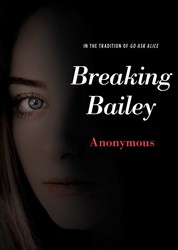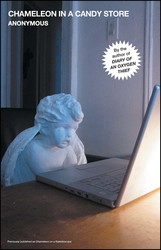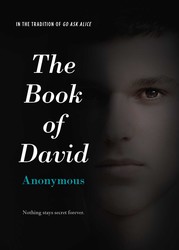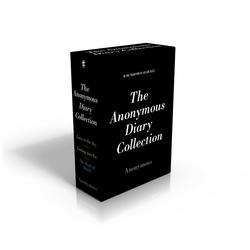Table of Contents
About The Book
A teen plunges into a downward spiral of addiction in this classic cautionary tale.
January 24th
After you’ve had it, there isn't even life without drugs…
It started when she was served a soft drink laced with LSD in a dangerous party game. Within months, she was hooked, trapped in a downward spiral that took her from her comfortable home and loving family to the mean streets of an unforgiving city. It was a journey that would rob her of her innocence, her youth—and ultimately her life.
Read her diary.
Enter her world.
You will never forget her.
For thirty-five years, the acclaimed, bestselling first-person account of a teenage girl’s harrowing decent into the nightmarish world of drugs has left an indelible mark on generations of teen readers. As powerful—and as timely—today as ever, Go Ask Alice remains the definitive book on the horrors of addiction.
January 24th
After you’ve had it, there isn't even life without drugs…
It started when she was served a soft drink laced with LSD in a dangerous party game. Within months, she was hooked, trapped in a downward spiral that took her from her comfortable home and loving family to the mean streets of an unforgiving city. It was a journey that would rob her of her innocence, her youth—and ultimately her life.
Read her diary.
Enter her world.
You will never forget her.
For thirty-five years, the acclaimed, bestselling first-person account of a teenage girl’s harrowing decent into the nightmarish world of drugs has left an indelible mark on generations of teen readers. As powerful—and as timely—today as ever, Go Ask Alice remains the definitive book on the horrors of addiction.
Reading Group Guide
A Reading Group Guide to
Go Ask Alice
By Anonymous
About the Book
She doesn’t want to get hooked on drugs. Every time after she uses, she feels guilty and low and vows to stay away. But she just can’t resist the way the drugs make her feel—beautiful and popular and connected to the world around her. And since nobody understands how alone and miserable she is without the drugs, how can they possibly understand how much she needs them? We may not know her name, but we can imagine how she feels as her diary records a descent into drug-induced madness.
Discussion Questions
1. Every time the narrator has something important happen in her life—a summer with her grandparents, her family’s move, an invitation to a big party—she focuses on her weight and clothing. How does this affect the way she sees herself, and how she relates to others? Do you see any connection or foreshadowing to events that happen later in the book?
2. As her family prepares to move, the narrator says, “‘Even now I’m not really sure which parts of myself are real and which parts are things I’ve gotten from books.’” What do you think she means by this? As time passes, what else does she use to define who she is? Are her methods healthy? Do you think she ever discovers her authentic self? Explain your answers.
3. How do you define identity? What or who contributes to the way you see yourself? How do you go about learning more about yourself?
4. The narrator does not feel like she fits in with her family, nor does she belong to any groups at school. What causes her to feel so separated and different? Do these reasons change throughout the course of the story? How do you feel about her? Why do you think she is misunderstood?
5. Describe the narrator’s relationship with her family, especially with her mother. Do you find anything unusual about their relationship?
6. The narrator makes friends at different times throughout the book, but none of them are in her life for very long. Why do these different friendships end? What does each person—Jill, Gerta, Beth, Chris—mean to the writer? Is she a good friend to each of them? Who do you think is the best friend to have? Explain your answers using evidence from the book.
7. As a reader, think about your role as an outside observer. What might you say to the narrator that she might not understand or notice about her own life? Do you agree with her interpretations of the people and events around her? Where else, besides drugs, could she have turned to address her problems?
8. The narrator spends time justifying her actions; for example, she says she only sells drugs to kids who would buy them anyway, and that she didn’t realize she was dropping acid the first time. What are some of her other excuses? Do you think she really believes all of these? Do you think any of her actions are justified? Explain your answers.
9. Why is it so hard for her to remain clean? Why do her former friends give her such a hard time? How might her situation change if she had someone she trusted to support her?
10. What do you notice about the tone and style of the narrator’s diary entries the second time she runs away from home? What do you think causes these changes? Explain your answers.
11. Why is the narrator so obsessed with death and what happens to bodies after they are buried? Do you think these thoughts affect the acid trip that lands her in the hospital?
12. How do you feel about the book’s ending? Do you think it fits with the rest of the story? Explain your answers.
13. There has been some debate about the authorship of this book, with some believing that it is not an actual diary, but a fictionalized account created by an editor or writer. Who do you think wrote the book? Do you think it’s an authentic portrayal of what it’s like to be a teenager in these circumstances? Would you feel differently about the book if you discovered it wasn't a real diary?
14. Go Ask Alice was written fifty years ago. Do you think it is still relevant today? How has life changed for young people today? What things are the same? Think about outlets like social media and how that impacts the way people portray themselves. Explain your answers.
Extension Activities
1. Many communities have a helpline for people to call when they feel they have no one to talk to. Check into opportunities with helplines or community groups and consider volunteering. Talk to your school about starting a peer-counseling group. You can help others just by listening to their stories.
2. Choose your favorite scene from the book and rewrite it from the perspective of one of the other characters, keeping with the diary format. How does it change your view of the situation?
3. The narrator tries to change her image several times throughout the story. Create a timeline that matches the narrator’s physical transformations with the events going on in her life. Include an illustration of the character at each stage. Do you notice any parallels or relationships between the two? What does this add to your understanding of the narrator? Think about building a similar timeline for your own life. Do you think you would make any surprising connections about yourself?
4. The narrator looks for ways to feel more connected, both to other people and to the world she lives in. Find something that makes you feel like you belong, and make it a part of your life. How might you involve others in your interests? How might you connect with your community?
5. Read another book that deals with teenagers and drugs, such as Crank by Ellen Hopkins and Smack by Melvin Burgess. Then write an essay comparing and contrasting the book to Go Ask Alice.
This guide has been provided by Simon & Schuster for classroom, library, and reading group use. It may be reproduced in its entirety or excerpted for these purposes. For more Simon & Schuster guides and classroom materials, please visit simonandschuster.net or simonandschuster.net/thebookpantry.
Go Ask Alice
By Anonymous
About the Book
She doesn’t want to get hooked on drugs. Every time after she uses, she feels guilty and low and vows to stay away. But she just can’t resist the way the drugs make her feel—beautiful and popular and connected to the world around her. And since nobody understands how alone and miserable she is without the drugs, how can they possibly understand how much she needs them? We may not know her name, but we can imagine how she feels as her diary records a descent into drug-induced madness.
Discussion Questions
1. Every time the narrator has something important happen in her life—a summer with her grandparents, her family’s move, an invitation to a big party—she focuses on her weight and clothing. How does this affect the way she sees herself, and how she relates to others? Do you see any connection or foreshadowing to events that happen later in the book?
2. As her family prepares to move, the narrator says, “‘Even now I’m not really sure which parts of myself are real and which parts are things I’ve gotten from books.’” What do you think she means by this? As time passes, what else does she use to define who she is? Are her methods healthy? Do you think she ever discovers her authentic self? Explain your answers.
3. How do you define identity? What or who contributes to the way you see yourself? How do you go about learning more about yourself?
4. The narrator does not feel like she fits in with her family, nor does she belong to any groups at school. What causes her to feel so separated and different? Do these reasons change throughout the course of the story? How do you feel about her? Why do you think she is misunderstood?
5. Describe the narrator’s relationship with her family, especially with her mother. Do you find anything unusual about their relationship?
6. The narrator makes friends at different times throughout the book, but none of them are in her life for very long. Why do these different friendships end? What does each person—Jill, Gerta, Beth, Chris—mean to the writer? Is she a good friend to each of them? Who do you think is the best friend to have? Explain your answers using evidence from the book.
7. As a reader, think about your role as an outside observer. What might you say to the narrator that she might not understand or notice about her own life? Do you agree with her interpretations of the people and events around her? Where else, besides drugs, could she have turned to address her problems?
8. The narrator spends time justifying her actions; for example, she says she only sells drugs to kids who would buy them anyway, and that she didn’t realize she was dropping acid the first time. What are some of her other excuses? Do you think she really believes all of these? Do you think any of her actions are justified? Explain your answers.
9. Why is it so hard for her to remain clean? Why do her former friends give her such a hard time? How might her situation change if she had someone she trusted to support her?
10. What do you notice about the tone and style of the narrator’s diary entries the second time she runs away from home? What do you think causes these changes? Explain your answers.
11. Why is the narrator so obsessed with death and what happens to bodies after they are buried? Do you think these thoughts affect the acid trip that lands her in the hospital?
12. How do you feel about the book’s ending? Do you think it fits with the rest of the story? Explain your answers.
13. There has been some debate about the authorship of this book, with some believing that it is not an actual diary, but a fictionalized account created by an editor or writer. Who do you think wrote the book? Do you think it’s an authentic portrayal of what it’s like to be a teenager in these circumstances? Would you feel differently about the book if you discovered it wasn't a real diary?
14. Go Ask Alice was written fifty years ago. Do you think it is still relevant today? How has life changed for young people today? What things are the same? Think about outlets like social media and how that impacts the way people portray themselves. Explain your answers.
Extension Activities
1. Many communities have a helpline for people to call when they feel they have no one to talk to. Check into opportunities with helplines or community groups and consider volunteering. Talk to your school about starting a peer-counseling group. You can help others just by listening to their stories.
2. Choose your favorite scene from the book and rewrite it from the perspective of one of the other characters, keeping with the diary format. How does it change your view of the situation?
3. The narrator tries to change her image several times throughout the story. Create a timeline that matches the narrator’s physical transformations with the events going on in her life. Include an illustration of the character at each stage. Do you notice any parallels or relationships between the two? What does this add to your understanding of the narrator? Think about building a similar timeline for your own life. Do you think you would make any surprising connections about yourself?
4. The narrator looks for ways to feel more connected, both to other people and to the world she lives in. Find something that makes you feel like you belong, and make it a part of your life. How might you involve others in your interests? How might you connect with your community?
5. Read another book that deals with teenagers and drugs, such as Crank by Ellen Hopkins and Smack by Melvin Burgess. Then write an essay comparing and contrasting the book to Go Ask Alice.
This guide has been provided by Simon & Schuster for classroom, library, and reading group use. It may be reproduced in its entirety or excerpted for these purposes. For more Simon & Schuster guides and classroom materials, please visit simonandschuster.net or simonandschuster.net/thebookpantry.
Product Details
- Publisher: Simon & Schuster Books for Young Readers (July 13, 1999)
- Length: 192 pages
- ISBN13: 9780689832499
- Ages: 12 - 99
- Lexile ® 930L The Lexile reading levels have been certified by the Lexile developer, MetaMetrics®
Awards and Honors
- School Library Journal Best Books of the Year
- ALA Best Books For Young Adults
- Popular Paperbacks for Young Adults
- Christopher Award
- ALA Best of the Best Books for Young Adults
Resources and Downloads
High Resolution Images
- Book Cover Image (jpg): Go Ask Alice eBook 9780689832499

















